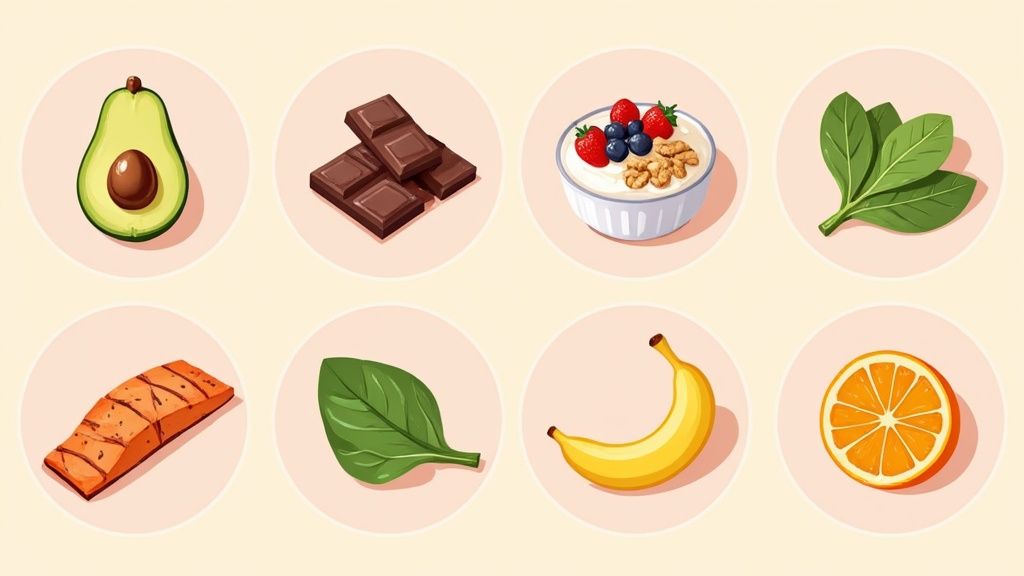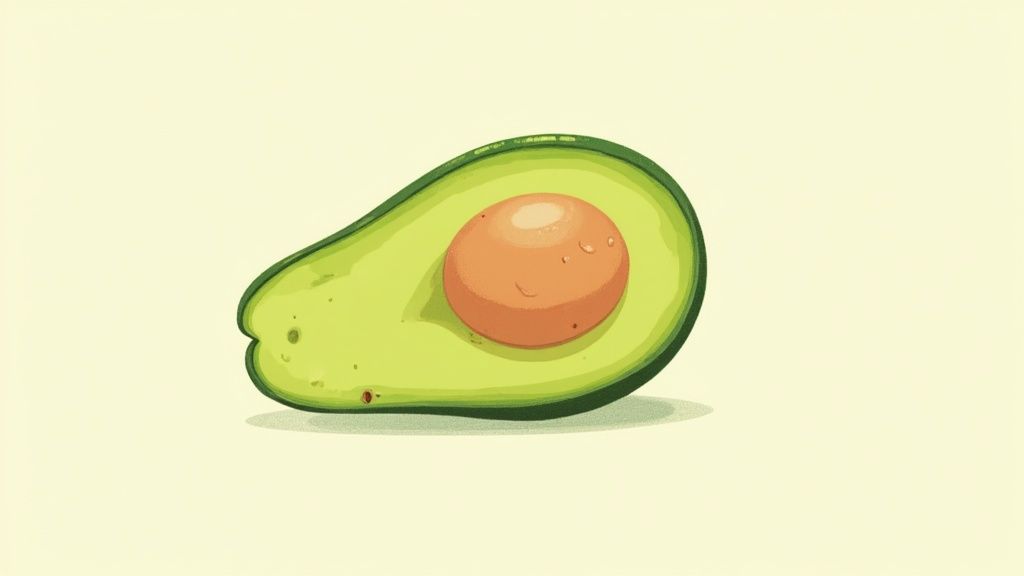8 Food to improve mood You Should Know

When you're feeling down or irritable, your first impulse might be to reach for sugary snacks or processed comfort foods. While these can provide a momentary lift, they often lead to a subsequent crash, leaving you feeling worse than before. The connection between what we eat and how we feel is powerful, and making strategic food choices can be a game-changing tool for managing your emotional well-being. The good news is that finding the right food to improve mood doesn't require a drastic diet overhaul or expensive, hard-to-find ingredients.
This guide is designed to give you a clear, actionable list of everyday foods that can genuinely support a more stable and positive mindset. We will explore how specific nutrients in items like fatty fish, dark chocolate, and even bananas directly influence your brain's chemistry. You will learn not just what to eat, but why it works and how to easily incorporate these foods into your daily routine for lasting benefits. Forget generic advice; this list provides practical tips to help you build a diet that nourishes both your body and your mind, leading to better energy, focus, and a brighter outlook. Let’s dive into the specific foods that can help you eat your way to a better mood.
1. Dark Chocolate
When searching for food to improve mood, dark chocolate often tops the list for good reason. It’s more than just a sweet treat; it’s a powerhouse of mood-boosting compounds. Rich in cocoa, dark chocolate contains flavonoids, phenylethylamine (PEA), and anandamide. Flavonoids are antioxidants that can reduce inflammation and improve blood flow to the brain, while PEA is a chemical your brain creates when you fall in love, encouraging the release of endorphins. Anandamide, often called the “bliss molecule,” binds to brain receptors to promote feelings of well-being.

This potent combination makes dark chocolate a scientifically supported tool for emotional health. Research highlights its effectiveness, with some studies showing that consuming about 40 grams daily can significantly reduce stress hormones like cortisol in just two weeks. It's so effective that it's even used in therapeutic settings for depression management and by corporate wellness programs to help employees combat stress.
How to Use Dark Chocolate for Mood Enhancement
To get the most benefits, choose a high-quality dark chocolate with at least 70% cocoa content, as this ensures a higher concentration of beneficial compounds and less sugar. Brands like Lindt Excellence and Green & Black's offer excellent high-cocoa options.
- Practice Mindful Consumption: Instead of eating it quickly, savor one or two small squares. Let the chocolate melt on your tongue, focusing on the texture and flavor. This mindful practice enhances the psychological benefits.
- Perfect Pairing: Combine a square of dark chocolate with a handful of almonds or walnuts. The healthy fats and protein in the nuts help stabilize blood sugar, preventing a crash and providing sustained energy.
- Strategic Snacking: Reach for dark chocolate during a mid-afternoon slump or after a stressful event. Its natural compounds provide a gentle lift without the jitters associated with caffeine or the crash from high-sugar snacks.
Key Insight: The magic of dark chocolate lies in its ability to trigger the release of endorphins and serotonin, the body's natural "feel-good" chemicals. This makes it a smart, delicious, and effective food to improve mood.
2. Fatty Fish (Salmon, Mackerel, Sardines)
When considering a food to improve mood, fatty fish like salmon, mackerel, and sardines are nutritional heavyweights. These cold-water fish are packed with omega-3 fatty acids, specifically eicosapentaenoic acid (EPA) and docosahexaenoic acid (DHA). These fats are fundamental building blocks for brain cells and play a crucial role in neurotransmitter function. They help reduce inflammation throughout the body, including the brain, which is linked to depression and mood disorders.

This powerful connection between omega-3s and mental wellness is supported by global dietary patterns. Research from Blue Zones, such as the Mediterranean, shows populations with high fish consumption have notably lower rates of depression. Similarly, traditional Japanese and Scandinavian diets, where fish is a primary protein, are associated with better mental health outcomes. This makes fatty fish a scientifically backed strategy for maintaining emotional balance and cognitive function. Learn more about how to boost your energy naturally with nutrient-dense foods.
How to Use Fatty Fish for Mood Enhancement
To reap the cognitive benefits, consistency is key. Aim to incorporate fatty fish into your meals two to three times per week. When possible, choose wild-caught varieties like wild Alaskan salmon, as they often contain higher levels of omega-3s than their farmed counterparts.
- Preserve the Nutrients: Opt for gentle cooking methods like baking, grilling, or steaming instead of deep-frying. This helps preserve the delicate omega-3 fatty acids and maximize their health benefits.
- Create a Synergistic Meal: Pair your fish with a large serving of leafy greens like spinach or kale. The vitamins and minerals in the greens work with the omega-3s to support overall brain health.
- Easy Integration: If cooking fish feels daunting, canned sardines or salmon are excellent, convenient options. Add them to salads, mix them into whole-wheat pasta, or enjoy them on whole-grain crackers for a quick and mood-boosting meal.
Key Insight: The EPA and DHA in fatty fish are essential for building healthy brain cell membranes and facilitating communication between brain cells. This direct support for brain structure makes fatty fish a foundational food to improve mood and cognitive resilience.
3. Fermented Foods (Yogurt, Kefir, Kimchi, Sauerkraut)
Emerging as a key category of food to improve mood, fermented foods leverage the powerful gut-brain axis. Your gut, often called the “second brain,” is home to trillions of bacteria that directly influence your mental state. Probiotic-rich foods like yogurt, kefir, kimchi, and sauerkraut introduce beneficial bacteria that help produce key neurotransmitters like serotonin and GABA right in your digestive system. This direct line of communication means a healthier gut can lead to a happier, more balanced mind.

The link between these foods and mental well-being is backed by compelling research. For instance, studies have associated regular consumption of yogurt with reduced anxiety, while traditional diets high in fermented foods, like Korean kimchi, are linked to lower rates of depression. This connection is popularized by experts like Dr. Emeran Mayer, who has extensively researched the profound impact of gut health on our emotions and cognitive function.
How to Use Fermented Foods for Mood Enhancement
To harness the benefits, focus on incorporating a variety of live-culture foods into your diet. Be sure to check labels for "live and active cultures" and opt for unsweetened versions to avoid counteracting the benefits with sugar.
- Start Small and Build Up: If you are new to fermented foods, begin with a small serving, like a tablespoon of sauerkraut or a few ounces of kefir. This allows your gut microbiome to adjust gradually without causing digestive discomfort.
- Diversify Your Sources: Different fermented foods contain different strains of beneficial bacteria. Rotate between yogurt, kimchi, kombucha, and kefir to cultivate a more diverse and resilient gut ecosystem for optimal mental health benefits.
- Incorporate into Daily Meals: Add a dollop of plain Greek yogurt to your morning smoothie, use kimchi as a zesty side for your lunch, or sip on kefir as a mid-afternoon snack. Consistent consumption is crucial for maintaining a healthy gut environment. Integrating these foods thoughtfully can be a form of mindful eating that enhances their benefits.
Key Insight: The gut-brain axis is a two-way street. By nourishing your gut with probiotics from fermented foods, you are directly supporting the production of mood-regulating neurotransmitters, making it a powerful and effective food to improve mood from the inside out.
4. Leafy Greens (Spinach, Kale, Swiss Chard)
When considering which food to improve mood, leafy greens like spinach, kale, and Swiss chard are foundational. These nutritional powerhouses are far more than simple salad ingredients; they are loaded with vitamins and minerals essential for optimal brain function. They are particularly rich in folate, magnesium, and iron, all of which play critical roles in producing mood-regulating neurotransmitters like serotonin and dopamine. A deficiency in these nutrients is often linked to higher rates of depression and fatigue.
The benefits are well-documented. Major studies, such as the Nurses' Health Study, have found a strong correlation between higher leafy green consumption and a lower risk of depression. This connection is a cornerstone of mood-supportive diets like the Mediterranean diet, which emphasizes daily intake. The green smoothie movement, popularized by figures like Dr. Joel Fuhrman, further cemented the reputation of greens as a tool for mental and physical vitality.
How to Use Leafy Greens for Mood Enhancement
To truly harness their benefits, aim to incorporate a variety of leafy greens into your diet daily. A target of 2-3 cups is ideal, as this provides a consistent supply of brain-boosting nutrients.
- Blend into Smoothies: This is the easiest way to consume a large quantity of greens. Combine a large handful of spinach or kale with a banana, berries, and almond milk. The sweetness of the fruit completely masks any bitter taste.
- Improve Texture and Taste: To make kale more palatable for salads, massage it with a bit of lemon juice and olive oil. This simple step breaks down the tough fibers, making it tender and easier to digest.
- Boost Nutrient Absorption: Lightly sautéing greens like Swiss chard or spinach with garlic and a healthy fat like olive oil can make their nutrients more bioavailable. This method also creates a quick and delicious side dish for any meal.
Key Insight: Leafy greens provide the essential building blocks, especially folate and magnesium, that your brain needs to synthesize serotonin. Consuming them regularly ensures your brain has the raw materials to maintain a stable and positive mood.
5. Nuts and Seeds (Walnuts, Pumpkin Seeds, Chia Seeds)
When looking for a dependable food to improve mood, nuts and seeds offer a powerful combination of nutrients for sustained emotional balance. These small but mighty foods are packed with healthy fats, protein, and fiber. Specifically, walnuts, pumpkin seeds, and chia seeds are rich in omega-3 fatty acids, magnesium, and tryptophan, which are all essential for supporting stable mood and healthy brain function. Tryptophan is an amino acid precursor to serotonin, a key neurotransmitter that regulates mood, while magnesium plays a vital role in the body's stress response.
The mood-boosting effects of nuts and seeds are backed by significant research and practical application. Studies from the California Walnut Commission have linked walnut consumption to improved mood states in young adults. Likewise, health advocates like Dr. David Perlmutter highlight their importance for brain health, while Paleo and keto communities praise them for providing stable energy without the blood sugar spikes that can lead to irritability. Their combination of healthy fats and protein helps prevent energy crashes, making them a cornerstone for emotional well-being.
How to Use Nuts and Seeds for Mood Enhancement
To harness their benefits, focus on incorporating a variety of raw or lightly roasted options into your daily routine. Stick to a portion size of about 1-2 ounces (a small handful) to manage calorie intake while still getting the nutritional perks.
- Create a Mood-Boosting Mix: Combine walnuts, pumpkin seeds, and a sprinkle of chia seeds for a diverse nutrient profile. This mix provides a balanced source of omega-3s, magnesium, and zinc.
- Add to Meals: Sprinkle seeds over your morning oatmeal, yogurt, or salad. Blend a tablespoon of chia seeds into a smoothie for added fiber and sustained energy that keeps you feeling good for hours.
- Smart Snacking Strategy: Keep a small container of mixed nuts and seeds at your desk or in your bag. Reaching for them instead of sugary snacks can prevent mood swings and support consistent energy levels throughout the day. Building this into your routine is a key step, and you can learn more about building healthy habits on stopsugar.app.
Key Insight: The power of nuts and seeds lies in their ability to provide the foundational building blocks for key neurotransmitters like serotonin. Their high content of omega-3s, magnesium, and tryptophan makes them a superior food to improve mood by stabilizing blood sugar and supporting brain health.
6. Bananas
Often seen as a simple, on-the-go snack, the humble banana is a surprisingly effective food to improve mood. This natural mood-boosting fruit is packed with vitamin B6, which is crucial for creating neurotransmitters like serotonin and dopamine. Bananas also contain tryptophan, an amino acid that serves as a precursor to serotonin, the body's primary "feel-good" chemical. This combination helps regulate emotions and promote a sense of calm and well-being.
The power of bananas is recognized across various fields. Athletes often consume them before or during competition not just for a quick energy boost from natural sugars, but to maintain mental focus and a positive state of mind. Likewise, many school lunch programs and hospitals include bananas in their menus, acknowledging their role in supporting stable energy and mood for students and patients. Their unique nutritional profile provides quick energy without the sharp spike and crash associated with processed sweets.
How to Use Bananas for Mood Enhancement
To maximize the mood-lifting benefits, it’s important to consume bananas strategically. The level of ripeness and what you pair them with can make a significant difference. A yellow banana with a few brown spots offers a good balance of easily digestible sugars and nutrients.
- Balance with Protein and Fats: To prevent a blood sugar dip and ensure sustained energy, pair a banana with a source of protein or healthy fat. Spreading a tablespoon of almond butter on banana slices is a perfect, balanced snack.
- Choose for Your Needs: A slightly green banana has more resistant starch and a lower glycemic index, providing a slower energy release. Overripe bananas are sweeter and ideal for freezing and blending into smoothies for a natural sweetener.
- Time Your Snack: Enjoy a banana mid-morning or mid-afternoon to head off a potential mood slump. The combination of B vitamins and tryptophan provides the building blocks your brain needs to maintain a positive outlook throughout the day.
Key Insight: Bananas are a convenient and affordable tool for mood management. Their rich content of vitamin B6 and tryptophan directly supports the production of serotonin, making them a powerful and natural food to improve mood.
7. Avocados
Known for their creamy texture and rich flavor, avocados are a premier food to improve mood thanks to their dense nutritional profile. This fruit is packed with healthy monounsaturated fats, which are crucial for optimal brain function and help reduce inflammation. Avocados are also an excellent source of folate, a B vitamin that plays a vital role in preventing the buildup of homocysteine, a substance that can impair circulation and the delivery of nutrients to the brain, thereby impacting mood regulation.

This powerful combination of healthy fats, folate, and potassium supports neurotransmitter production and provides sustained energy, preventing the mood swings associated with blood sugar spikes. The rise of avocado toast, popularized by health-conscious millennials and food bloggers, highlights its transition from a simple ingredient to a wellness staple. Diets like the Mediterranean and California styles frequently feature avocados, linking them to better cognitive health and emotional stability.
How to Use Avocados for Mood Enhancement
To reap the full psychological benefits, aim to incorporate avocado into your diet regularly. Its versatility makes it easy to add to almost any meal. Brands and organizations like the Hass Avocado Board have successfully marketed its health advantages, making it a go-to for wellness enthusiasts.
- Make it a Daily Habit: Eating half an avocado daily provides a potent dose of mood-stabilizing nutrients. Add it to salads, sandwiches, or simply enjoy it with a sprinkle of salt and pepper.
- Boost Your Smoothies: Blend a quarter of an avocado into your morning smoothie. It adds a wonderfully creamy texture while packing in healthy fats and fiber for sustained energy and focus.
- Smart Pairings: Combine sliced avocado with leafy greens like spinach. The healthy fats in the avocado help your body better absorb fat-soluble vitamins (A, D, E, K) from the greens, amplifying the overall nutritional benefit.
Key Insight: Avocados support mental well-being by providing the healthy fats and B vitamins necessary for stable brain function. Their ability to regulate blood sugar and support neurotransmitter synthesis makes them a fantastic food to improve mood and maintain cognitive clarity.
8. Oats and Whole Grains
When considering a reliable food to improve mood, oats and other whole grains provide a steady foundation for emotional stability. Unlike refined carbohydrates that cause sharp spikes and crashes in blood sugar, these complex carbs ensure a slow and sustained release of glucose to the brain. This stable energy supply prevents the irritability and fatigue associated with blood sugar fluctuations. Furthermore, whole grains are rich in tryptophan, an amino acid the body converts into serotonin, a key neurotransmitter for happiness and well-being.
The mood-stabilizing effects of oats are widely recognized. In many Scandinavian countries, oatmeal is a breakfast staple valued not just for physical energy but for its contribution to mental wellness. Athletes also rely on oats for sustained energy and mood regulation during intense training. This simple grain is a scientifically backed choice, with its high fiber content supporting a healthy gut microbiome, which is directly linked to mental health.
How to Use Oats and Whole Grains for Mood Enhancement
To maximize the benefits, focus on minimally processed grains that retain their natural fiber and nutrients. Opt for steel-cut or rolled oats over instant varieties, which often contain added sugars and have a higher glycemic index.
- Build a Better Breakfast: Start your day with a bowl of oatmeal. Top it with berries for antioxidants, a sprinkle of chia seeds for omega-3s, and a handful of walnuts for healthy fats and protein. This combination creates a powerful mood-supporting meal.
- Prepare for Convenience: Make a batch of overnight oats for a quick and easy morning. Combine rolled oats with milk or a milk alternative, Greek yogurt, and your favorite toppings in a jar. Let it sit in the fridge overnight for a delicious, ready-to-eat meal.
- Incorporate Throughout the Day: Don't limit whole grains to breakfast. Use whole-wheat bread for sandwiches, add quinoa to salads, or enjoy a side of brown rice with dinner. This ensures you’re getting a consistent supply of mood-stabilizing complex carbohydrates.
Key Insight: The power of oats and whole grains is in their ability to regulate blood sugar and support serotonin production. This dual action makes them an essential food to improve mood by preventing energy crashes and promoting a sense of calm well-being.
Mood-Boosting Foods Comparison Table
| Item | Implementation Complexity 🔄 | Resource Requirements ⚡ | Expected Outcomes 📊 | Ideal Use Cases 💡 | Key Advantages ⭐ |
|---|---|---|---|---|---|
| Dark Chocolate | Low - ready to eat, minimal prep | Moderate - purchase quality bars | Immediate mood boost, reduced stress | Quick mood enhancement, snacks | Scientifically proven, enjoyable |
| Fatty Fish | Moderate - cooking required | Higher - cost and freshness | Long-term brain health, lowers depression | Regular meals, cognitive support | Omega-3 rich, multiple cooking ways |
| Fermented Foods | Moderate - some prep or purchase | Moderate - variety of products | Improved gut health, reduced anxiety | Digestive & mental health support | Gut-brain benefits, probiotics |
| Leafy Greens | Low - easy to prepare/eat | Low - widely available | Sustained mood, brain protection | Daily nutrient boost | Nutrient-dense, versatile |
| Nuts and Seeds | Low - ready to eat, minimal prep | Moderate - cost of quality nuts | Stable mood, sustained energy | Portable snacks, meal add-ons | Nutrient-rich, portable |
| Bananas | Very low - eat raw | Low - inexpensive, widely found | Quick energy, mood stabilization | On-the-go energy | Portable, fast-acting |
| Avocados | Low - minimal prep | Moderate to high - cost varies | Stable mood, sustained energy | Meal enhancement, brain health | Healthy fats, versatile |
| Oats and Whole Grains | Low to moderate - cooking needed | Low - affordable, shelf-stable | Steady energy, mood stabilization | Breakfast, meal base | Fiber-rich, supports brain & gut |
Final Thoughts
Navigating the connection between your plate and your state of mind doesn't have to be complicated. Throughout this guide, we've explored a variety of delicious and accessible food to improve mood, moving beyond temporary fixes and toward sustainable, positive change. The journey to a brighter outlook can genuinely begin in your kitchen.
The key takeaway is that consistency, not perfection, is the goal. You don't need to overhaul your entire diet overnight. Instead, focus on small, intentional additions. Adding a handful of walnuts to your morning oatmeal, swapping a sugary snack for a banana, or incorporating fermented foods like yogurt into your routine are simple yet powerful steps. These choices are not about restriction; they are about empowerment, giving your body and brain the essential nutrients they need to function optimally.
Your Action Plan for a Better Mood
Feeling motivated? Here’s a simple plan to put these insights into action and start reaping the benefits.
- Start Small: Choose just one or two foods from our list to incorporate into your meals this week. Maybe it's adding spinach to your eggs or snacking on pumpkin seeds.
- Plan Ahead: A little preparation goes a long way. Chop some veggies, portion out nuts, or make a batch of overnight oats. This makes the healthy choice the easy choice when you're busy or stressed.
- Track Your Feelings: Pay attention to how you feel. A simple note in a journal or on your phone can help you recognize the subtle but significant shifts in your energy levels and emotional state. This feedback loop is incredibly motivating.
Key Insight: The relationship between food and mood is a powerful two-way street. By nourishing your body with brain-healthy foods, you are actively building a foundation for greater emotional resilience, sharper focus, and a more stable, positive outlook.
Mastering the art of using food to improve mood is one of the most effective forms of self-care. It’s a proactive strategy that addresses the root causes of mood swings and energy crashes, rather than just managing the symptoms. The benefits extend far beyond feeling happier; they include enhanced cognitive function, better stress management, and a reduced risk of long-term health issues.
Embrace this journey with curiosity and kindness. Every meal is an opportunity to nourish yourself, support your mental well-being, and build a healthier, happier you from the inside out. Your next bite could be your next step toward a brighter day.